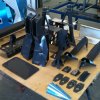PREKOTE SURFACE PRE TREATMENT | UNDERCOAT FOR ALLOYS & COMPOSITES
Marcos I did research on this for my tub.
Paint will not stick to alloy was the outcome.
Hence the phosphate coatings then the paint will adhere to that.
I used this and am very happy.
I have only primed at this point it is Dulux super ufi etch.
I have to say it is very tough, it gets used as a bench at times and no marks.
I have not painted top coat yet so I have no advice in that area.
I did look at aero paints but I decided against it as it was not practical for me.
Jim
Marcos I did research on this for my tub.
Paint will not stick to alloy was the outcome.
Hence the phosphate coatings then the paint will adhere to that.
I used this and am very happy.
I have only primed at this point it is Dulux super ufi etch.
I have to say it is very tough, it gets used as a bench at times and no marks.
I have not painted top coat yet so I have no advice in that area.
I did look at aero paints but I decided against it as it was not practical for me.
Jim




